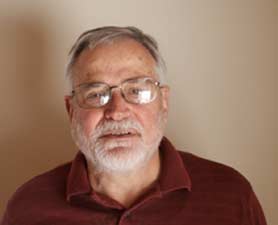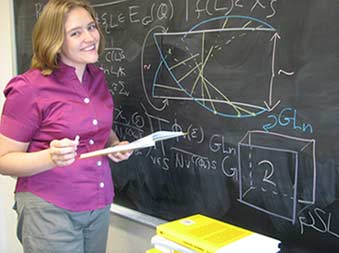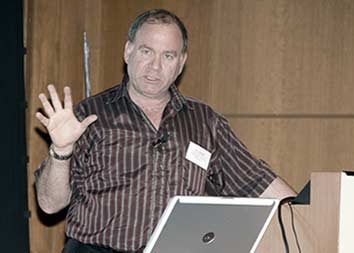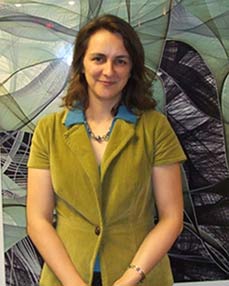George Papanicolaou to deliver the AMS Gibbs Lecture

George Papanicolaou, Stanford University, will deliver the AMS Josiah Willard Gibbs Lecture on Thursday, January 6, 2011, 8:30 p.m. - 9:30 p.m, in the Great Ballroom A-C, 5th Floor, Sheraton. He will speak on Mathematical problems in Systemic Risk. Listen
to George Papanicolaou's talk with AMS Public Awareness Officer Mike Breen about his address. Listen
to George Papanicolaou's talk with AMS Public Awareness Officer Mike Breen about his address.
George Papanicolaou obtained his PhD in mathematics in 1969 at the Courant Institute of Mathematical Sciences, New York University. He was assistant professor, associate and then professor of mathematics there until 1993 at which time he moved to the mathematics department at Stanford University where he is the Robert Grimmett Professor of Mathematics. He is a member of the US National Academy of Sciences and a Fellow of the American Academy of Arts and Sciences.
In 2006 he received the von Neumann Prize from the Society of Industrial and Applied Mathematics and in 2010 the William Benter Prize in Applied Mathematics from the City University of Hong Kong.
In the past he has been interested in waves and diffusion in inhomogeneous or random media and in the mathematical analysis of multi-scale phenomena that arise in their study. Applications come from electromagnetic wave propagation in the atmosphere, underwater sound, waves in the lithosphere, diffusion in porous media, etc. He has studied both linear and nonlinear waves and diffusion, in both direct and inverse problems. In the past few years he has been working on assessing multiple scattering effects in imaging and communication systems, including time reversal arrays. Another recent interest is financial mathematics, especially the use of asymptotics for stochastic equations in analyzing complex models of financial markets involving stochastic volatility and in data analysis.
Abstract: The quantification of uncertainty in complex systems depends on the individual uncertainty of their components, the connectivity of the system and on the way uncertainty evolves over time. Quantifying systemic risk for a complex system means identifying regimes in which small changes in individual components can cause catastrophic failure of the whole system. How can we characterize mathematically such regimes of fragility that may remain hidden and difficult to detect? I will address the mathematical modeling of systemic risk in complex systems and give examples from finance (banking, credit cards), power systems, ecological systems, complex engineering systems, etc., and discuss some old and some new mathematical methods for dealing with these issues."
Melanie Wood to speak on Binary Quadratic Forms: from Gauss to Algebraic Geometry

Melanie Matchett Wood, American Institute of Mathematics and Stanford University, will deliver a MAA Invited Address on Saturday, January 8, 2011, 2:15 p.m. - 3:05 p.m, in the Great Ballroom A-C, 5th Floor, Sheraton. She will speak on Binary quadratic forms: From Gauss to algebraic geometry.
Melanie Wood received her B.S. from Duke University in 2003, completed Part III of the Mathematical Tripos at the University of Cambridge in 2004, and received her PhD from Princeton University under the supervision of Manjul Bhargava in 2009. She is currently a Szego Assistant Professor in the mathematics department at Stanford University and an American Institute of Mathematics Five-Year Fellow. Melanie was a Putnam Fellow in 2002 and won the AMS-MAA-SIAM Morgan Prize in 2003. In 2008, she won a American Association of University Women Dissertation Fellowship and a Josephine De Karman Dissertation Fellowship. Melanie's research interests include algebraic number theory and algebraic geometry.
Abstract: Gauss's composition law on binary quadratic forms with integral coefficients is one of the gems of number theory that has
been leading to new mathematics for over 200 years. We will see how these simple quadratic polynomials of two variables can be themselves multiplied via a group law discovered by Lagrange, Legendre, and Gauss before there was a concept of an abstract group. These quadratic forms are linked to unique factorization and its failure in most rings of numbers larger than the integers. We will further explore what happens when the coefficients of the polynomials are allowed to be from rings larger than the integers and how we are led to new kinds of binary quadratic forms, eventually taking their coefficients in rings of functions on geometric spaces and telling us about the geometry of those spaces.
Top of page
Alexander Lubotzky to speak on Expander Graphs in Pure and Applied Mathematics

Alexander Lubotzky, The Hebrew University of Jerusalem, will deliver:
- Colloquium Lectures I on Thursday, January 6, 2011, 1:00 p.m. - 2:00 p.m.
He will speak on Expander graphs in pure and applied mathematics, I
- Colloquium Lectures II on Friday, January 7, 2011, 1:00 p.m. - 2:00 p.m.
He will speak on Expander graphs in pure and applied mathematics, II
- Colloquium Lectures III on Sunday, January 9, 2011, 8:50 a.m. - 9:50 a.m.
He will speak on Expander graphs in pure and applied mathematics, III
These lectures will be held in Great Ballroom A-C, 5th Floor, Sheraton Hotel. Lecture notes can be found by clicking here.  Listen
to Part 1 and Part 2 of Alexander Lubotzky's talk with AMS Public Awareness Officer Mike Breen about his lectures and his experiences in the Israeli Parliament. Listen
to Part 1 and Part 2 of Alexander Lubotzky's talk with AMS Public Awareness Officer Mike Breen about his lectures and his experiences in the Israeli Parliament.
Alexander Lubotzky has made fundamental contributions in group theory and its applications to geometry, arithmetic and combinatorics. His wide-ranging interests include topics such as the discrete subgroups of Lie groups, hyperbolic geometry, p-adic analytic groups, subgroup growth, pro-finite groups, finite simple groups and their combinatorics. His work with Sarnak and Phillips on the explicit construction of Ramanujan graphs via modular forms and the problem of distributing points on the sphere were the subjects of Bourbaki reports and attracted a great deal of attention in computer science and engineering.
Lubotzky is the Weil Professor of Mathematics at the Hebrew University of Jerusalem, and has held visiting positions at Columbia, Yale, Stanford, and the University of Chicago. During the academic year 2005/06 he led a year-long program at the Institute for Advanced Study at Princeton on “Lie Groups, Representations, and Discrete Mathematics."
He has published 3 books and more than 100 papers. His name appears in the ISI list of most cited scientists. He has received various prizes including the Erdős prize, the Rothschild prize, and twice the Ferran Sunyer L. Baloger prize for his research monographs “Discrete Groups, Expanding Graphs, and Invariant Measures" and “Subgroup Growth" (written with D. Segal). He was an invited speaker at the Zurich ICM in 1994 and gave the Woodward lectures at Yale in 1998, the Ritt lectures at Columbia in 1999, the Eilenberg lectures in 2000, the Porter lectures at Rice in 2001, and the Distinguished Lecture Series at UCLA in 2004.
In 2005, Lubotzky was elected to the American Academy of Arts and Sciences as a foreign honorary member and in 2006, he received an honorary degree from the University of Chicago for his contributions to modern mathematics.
Lubotzky was a member of Knesset (the Israeli parliament) during the years 1996-99. He is married to Yardenna and they have six children.
Top of page
Robert Bell to speak on Lessons from the Netflix Prize

Robert M. Bell, AT&T, will deliver a MAA Invited Address on Sunday, January 9, 2011, 10:05 p.m. - 10:55 a.m, in the Great Ballroom A-C, 5th Floor, Sheraton. He will speak on Lessons from the Netflix Prize.
 Listen
to Robert Bell's talk with MAA Editorial Assistant, Laura McHugh, about his address. Listen
to Robert Bell's talk with MAA Editorial Assistant, Laura McHugh, about his address.
Robert M. Bell received a Ph.D. in statistics from Stanford University in 1980. After spending 18 years at RAND doing public policy analysis, he joined the Statistics Research Department at AT&T Labs-Research. His research interests range from machine learning methods to survey research methods. He was a member of the team that won the Netflix Prize competition in 2009. Bell has served on the Fellows Committee of the American Statistical Association, the board of the National Institute of Statistical Sciences, the Committee on National Statistics, and several National Research Council advisory committees studying statistical issues from conduct of the decennial census to airline safety.
Abstract: In October 2006, the DVD rental company Netflix released more than 100 million user ratings of movies for a competition to predict new ratings based on prior ratings. The size of the data (over 17,000 movies and 480,000 users) and the nature of human-movie interactions produced many modeling challenges. One allure to data analysts around the world was a $1,000,000 prize for a team achieving a ten percent reduction in root mean squared prediction error relative to Netflix’s existing algorithm. Besides producing a photo finish worthy of a movie, the 33-month competition spurred numerous advances in the science of recommender systems and machine learning, more generally. After describing some of the techniques used by the leaders, I will offer lessons and raise some questions about building massive prediction models; the role of statistics, computer science, and mathematics in such endeavors; and prizes as a way to advance science. This is joint work with Chris Volinsky and Yehuda Koren, current and former colleagues at AT&T Labs-Research.
Katherine Socha to speak on Sea battles, Benjamin Franklin's oil lamp, and jellybellies

Katherine Socha, Saint Mary's College of Maryland, will deliver a MAA Invited Address on Friday January 7, 2011, 9:00 a.m. - 9:50 a.m., in the Great Ballroom A-C, 5th Floor, Sheraton. She will speak on Sea battles, Benjamin Franklin's oil lamp, and jellybellies.
 Listen
to Katherine Socha's talk with MAA Editorial Assistant, Laura McHugh, about her address. Listen
to Katherine Socha's talk with MAA Editorial Assistant, Laura McHugh, about her address.
Katherine Socha is an associate professor of mathematics at St. Mary's College of Maryland and a 2009-2011 AAAS Science and Technology Policy Fellow placed in the Division of Mathematical Sciences at the National Science Foundation. Her scholarly interests include mathematical fluid dynamics and partial differential equations, and she has a sneaking fondness for category theory. In 2008, she received both a Lester R. Ford award (for an American Mathematical Monthly article of expository excellence) and a Henry L. Alder award (for distinguished teaching) from the MAA. She was also a 2002-2003 Project NExT Fellow and a co-author, with Barry Cipra, of the 2001 Mathematics Awareness Month Theme Essay, "Math and the Ocean."
Abstract: During our passage to Madeira, the weather being warm, and the cabbin windows constantly open for the benefit of the air, the candles at night flared and run very much, which was an inconvenience. At Madeira we got oil to burn, and with a common glass tumbler or beaker, slung in wire, and suspended to the cieling of the cabbin, and a little wire hoop for the wick, furnish'd with corks to float on the oil, I made an Italian lamp, that gave us very good light...." (Benjamin Franklin, December 1, 1762, letter to John Pringle)
Observations of real phenomena have led to mathematical modeling of surface water waves, interfacial waves, and Lagrangian coherent structures, among other examples. This expository talk will provide a quick tour of the (mostly advanced undergraduate level) mathematics needed to describe idealized versions of the rings formed by striking a surface of water with a large object (like a bomb), the oil-water waves observed by Founding Father Benjamin Franklin on his voyage to Madeira, and the motion of nutrient laden water being swept into the underbelly of swimming jellyfish.
Top of page |